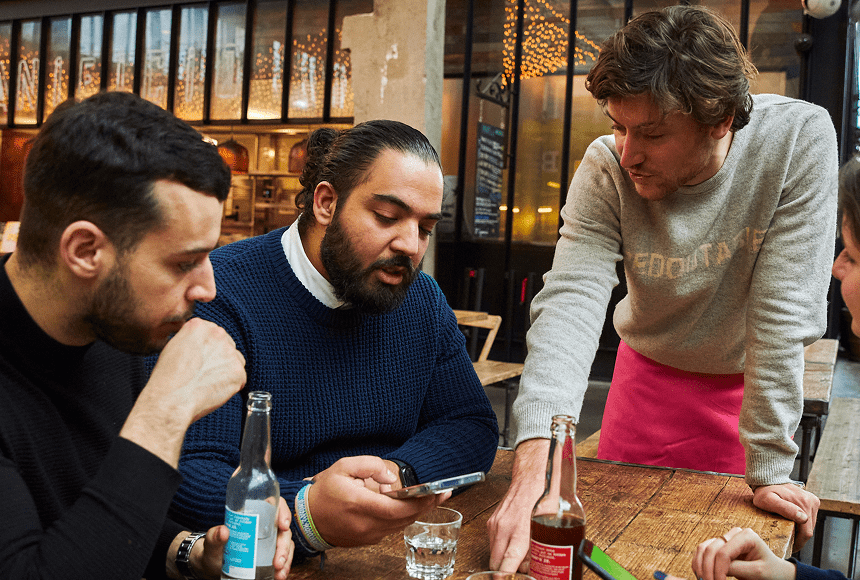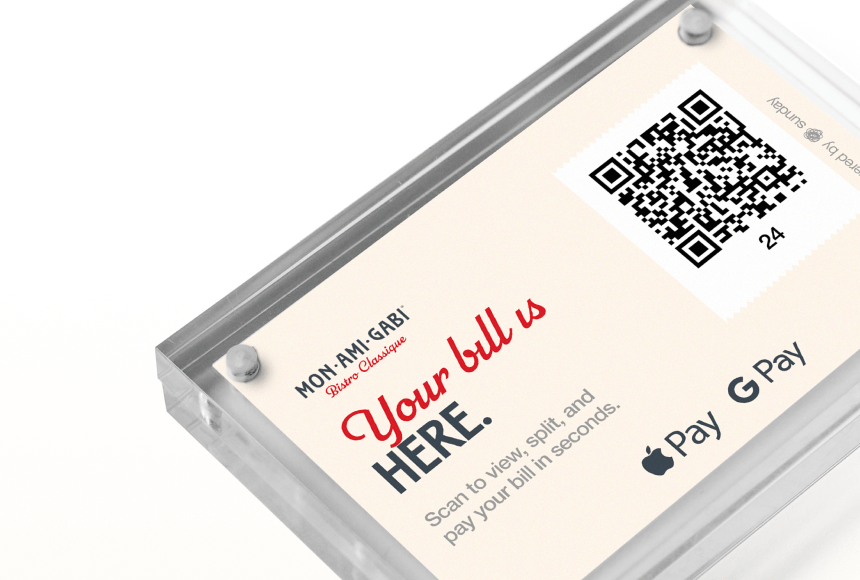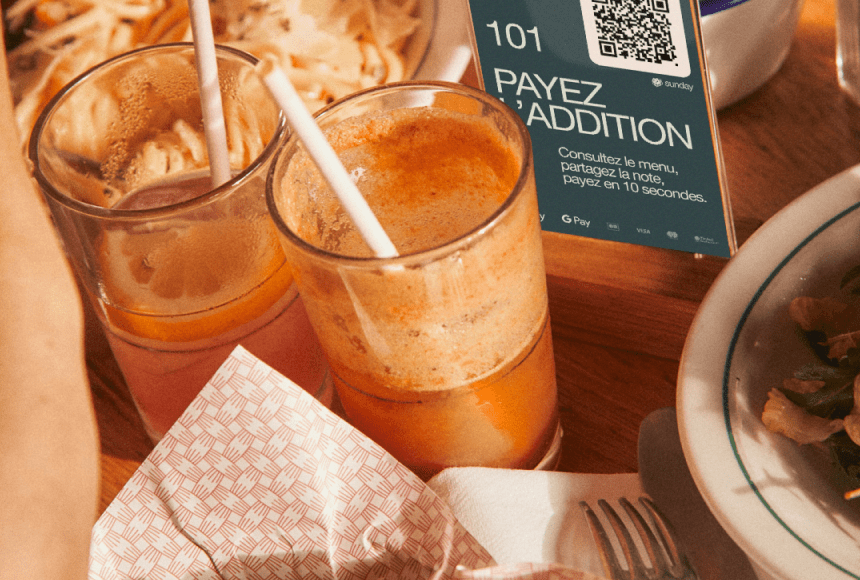Beyond Mere Contactless: Embracing the Full Power of QR in Your Restaurant
Setting the Table: A Look at Contactless Adoption
Contactless has certainly been a hot topic in the restaurant world over the past few years. Swiping or dipping credit cards is slowly becoming a relic of the past, replaced by tapping a card or using digital wallets for quick, touch-free payments. But while “contactless” surely feels modern, anyone who’s been behind the scenes of a busy restaurant knows that it’s only a fraction of what’s possible. Indeed, a recent Statista overview of global contactless payment usage highlighted that more than 80% of consumers have made at least one contactless payment within the past year. Those numbers shine a light on an industry-wide shift—but the bigger change is yet to come.
Why? Because simply tapping a phone or contactless card doesn’t necessarily solve the biggest challenges that many restaurant owners face: managing table turns, encouraging customers to leave reviews, easing tip workflows, and consolidating data to boost business insights. That’s where full QR integration comes in. Instead of gluing a contactless reader onto an older system, forward-thinking restaurants are syncing their entire guest journey—from ordering and payment all the way to feedback—under one dynamic QR system.
In this article, we’ll explore why going beyond contactless matters and how full QR integration can revolutionize how you run your business. If you’ve been wondering how to simplify operations, reduce wait times, and keep customers happier (and tipping more), then stick with me. Think of it like upgrading from a basic set menu to a custom-tasting experience: the difference is huge, and your guests will savor every moment.
The Missing Ingredient: Why Contactless Alone Falls Short
When contactless payment terminals (or POS terminals) first hit the market, they felt game-changing. Customers could tap, reduce physical contact, and speed up payment. It certainly checked the box of cutting down friction. However, as many restaurant operators quickly discovered, simply removing the swipe or dip didn’t tackle a host of other pain points:
- Multiple devices still in play: Many restaurants that rely on basic contactless methods still juggle separate devices—tablets for online orders, older cash registers for in-person payments, and payment terminals for contactless taps.
- Exposure to hardware glitches: If that same contactless device fails or starts glitching, you’re back to the old routine of having servers sprint to the table with a fallback solution.
- Customer interaction bottleneck: Even when tapping is quick, a server must still present the payment device. With large groups, you might lose a few minutes on each transaction while you wait for each diner to finish paying.
- Limited data insight: Basic contactless transactions rarely capture those valuable customer insights: email addresses, ratings, or the story behind a best-selling dish. You’re collecting payments, but not collecting knowledge.
In other words, contactless payment solves the “touch” problem but leaves other essentials cornered. It’s akin to having a state-of-the-art oven that only cooks on one setting. Sure, it might solve one problem, but you’re missing out on a full range of benefits by not upgrading to an integrated solution.
Full QR Integration Explained: A Unified Dining Experience
So, what exactly is “full QR integration”? Think of it as a single QR code that customers can scan to do everything: view the menu, place orders or add more dishes mid-meal, split the check, tip, provide feedback, and even post reviews to platforms like Google. It’s an ecosystem. Instead of working multiple devices for different tasks, you consolidate it all under a QR interface—one that each customer can interact with in real time. Here’s what sets it apart:
- Seamless ordering: Customers access your real-time menu with a quick scan. No need for physical menus that wear out, and no complex kiosk devices that break down at the worst possible moment.
- Effortless tipping: Prompt tipping is integrated right into the payment flow. Diners can add a tip with a simple tap, meaning you can boost server earnings while satisfying customers looking for an easy, discreet way to tip.
- Automated feedback: Full QR integration can prompt guests to share their experience—even nudging them to post a quick review on social platforms or Google, which is gold for your restaurant’s visibility.
- Data-driven insights: QR solutions, particularly those built for restaurants, capture valuable data—average spend, top menu items, time spent at table, bounce rates on certain digital menu pages… You name it, it’s trackable.
Whether your place is a craft burger joint or an elegant bistro, a QR-based platform can become the central nervous system of your guest experience. It’s user-friendly for customers, decreases manual errors for servers, and opens new possibilities for you to optimize and refine.
Breaking the Resistance: Common Myths About QR Systems
While QR systems are on the rise, some restaurant owners still hesitate, often due to a handful of myths:
- Myth #1: Customers don’t like technology at the table. In reality, consumers have become increasingly comfortable scanning QR codes. A Forbes article on QR code adoption points out that QR code usage in the U.S. has surged in recent years, and the pandemic only sped up that trend. If the system is convenient and genuinely enhances service, most people embrace it wholeheartedly.
- Myth #2: QR-based ordering or payments are unpersonalized. Actually, removing the friction of waiting for a server to bring the check can allow your staff to focus on more meaningful interactions—greeting customers, sharing chef recommendations, or explaining the day’s specials. You’re not removing human contact; you’re making it more intentional and higher value.
- Myth #3: It’s complicated to set up. The right QR solution will integrate seamlessly with your existing POS system and can be configured quickly. Implementation is often easier than you’d think, especially with a few basic staff and customer tutorials.
- Myth #4: Tips will drop. Some owners fear that new technology might lower tips. But it’s often the opposite. Integrated tipping prompts, especially ones that make the tipping process effortless, can boost your team’s overall tip revenue.
A Glimpse at Full QR in Action: The “La Mesa Brava” Case
Let’s consider a quick example to show how this might look in real life. Picture a bustling Mexican restaurant named “La Mesa Brava.” During peak hours, their servers scramble with multiple tasks—delivering food, refilling drinks, answering questions, running payments. The owner, Sofia, decides to implement a full QR integration to ease the madness.
On each table, she places a small sign with a unique QR code. Customers scan it to view the digital menu. No more flipping through a sticky plastic menu page; the item details are always up to date. They can also reorder quickly—there’s even a “Favorite Items” section highlighting top dishes. When the meal ends, each guest can simply scan that same code and choose how to pay: Apple Pay, Google Pay, credit card, or just about any major method. They finalize the tip at the same time. The entire process, from scanning to payment, might take a fraction of the time that old card readers required.
Immediately, Sofia notices several advantages:
- Improved table turnover: With customers no longer waiting for a manual payment process, tables free up faster during rush hour.
- Lighter staff workload: Servers can focus on quality interactions. If a group wants to add guacamole halfway through the meal, they simply tap “Add to Order,” and a ticket prints in the kitchen. That’s fewer steps for the server, and more time for them to engage with diners who need extra attention or food recommendations.
- Increased tips: The initial results show a 12% average increase in tip percentages. People find it convenient to tip when paying digitally, especially with suggested percentages displayed as a gentle nudge.
- Useful feedback loop: The solution automatically sends a push asking for feedback, and even prompts satisfied customers to leave a Google review. Within a few weeks, “La Mesa Brava” sees a rise in its online rating, pulling in new curious guests.
It’s a domino effect: less hassle, happier customers, more revenue. This example might resonate if you’ve ever wrestled with outdated processes in a busy dining room. And that’s the inherent beauty of full QR integration—it ties everything together in one accessible ecosystem.
Data Speaks: Tracking and Analysis Through QR Integration
Analytics are the beating heart of many modern eateries, but gleaning the right insights from scattered tools is often a headache. With full QR integration, your restaurant management can gather data points in one place. Consider these possibilities:
- Real-time order frequency: Spot which dishes are hot sellers and which ones might need rethinking. You can see what gets re-ordered often, which can influence your menu planning.
- Peak payment times: Identify when customers typically request the check, so you can pre-empt bottlenecks during your busiest hours.
- Review funnel statistics: Monitor how many guests are clicking through to leave feedback or ratings. If you notice fewer reviews one month, you might tweak your post-payment messaging.
- Tip behavior by time of day: Compare tips across lunch, brunch, dinner, or late-night. You might discover that dinner guests tip more generously after dessert suggestions, prompting you to train staff differently or create strategic upsells.
These data-driven insights help you refine not just your payment process, but also your menu mix, staff scheduling, and overall approach to customer engagement. Knowledge is power, and full QR integration puts that power at your fingertips—no guesswork required.
Implementation 101: Getting Started with Full QR Integration
Introducing a new system might feel daunting, but it doesn’t have to be a chore. Here are key steps to smooth the transition:
- Assess your current tech stack: Make an inventory of your existing POS system, reservation software, inventory management tools, and any loyalty or CRM platforms. You’ll want a QR solution that integrates seamlessly with what you already have in place.
- Choose a reliable partner: Work with a tried-and-tested provider who specializes in restaurant-specific QR integrations. They’ll know typical pitfalls and can offer a set-up that fits your size, style, and budget.
- Train your staff: Before rollout, gather your employees for a hands-on training session. Let them experience scanning, ordering, paying, and tipping from a customer’s perspective. That way, they can guide guests with confidence.
- Update your signage and table setup: Print sleek table signs or coasters with clear instructions. Keep the code scannable and easy to locate. If you have an outdoor patio, make sure the codes remain intact and weatherproof.
- Promote to your customers: Spread the word on social media and inside the restaurant. Let guests know they can order and pay at their own pace—no rush, no hold-ups. Highlight the convenience. You might be surprised how many regulars are excited to test it out.
- Observe and adjust: Monitor how smoothly the system works during the first week. Collect staff and customer feedback. Tweak language prompts, tip suggestions, or menu layouts as needed.
Once everything is in place, you’ll see how quickly the system becomes second nature. Much like perfecting a signature dish, it’s all in the preparation and fine-tuning.
Why This Moment Matters: QR Payments and Evolving Consumer Habits
It’s not just restaurants that are going digital. Retail, banking, even entertainment venues—QR codes are popping up everywhere. According to the National Restaurant Association’s article on restaurant tech trends, the speed at which diners expect convenience is accelerating. After all, people can order groceries with a single tap on their phone. They can schedule a ride or watch a movie without leaving the couch. Why would they want to stand around waiting for a payment terminal to arrive?
This shift in consumer outlook toward “instant everything” is precisely why full QR integration resonates so clearly with modern diners. They want control over their experience, and they want it now. Restaurants adapting to this mindset can cultivate stronger loyalty, positive word-of-mouth, and the chance to stand out in a crowded market. It’s not just a novelty; it’s the next logical step in the hospitality journey.
Maximizing Guest Engagement: More Than Just Payment
Once you implement a QR system, you might realize you’re able to capture guest attention over a longer arc. How so?
- Direct marketing channels: Collecting emails or phone numbers during the payment process benefits your marketing efforts. With consent, you can send personalized offers or event invites.
- Loyalty integration: Some advanced QR solutions sync up with loyalty programs, tracking points or rewards automatically. That’s a big plus for repeat customers and can nudge occasional guests toward a second visit.
- Menu storytelling: Digital menus allow you to include more imagery, short videos, or the story behind each dish. This is especially valuable for farm-to-table concepts where ingredient sourcing is a big selling point.
- Advertising new offerings: Rolling out a seasonal special or a new cocktail recipe? You can embed a banner in your QR menu, ensuring visitors see it right away, instead of hoping a physical menu insert gets their attention.
In short, “full QR integration” isn’t just a clever way to take payments; it’s a channel to showcase your brand narrative, reward loyal customers, and entice new ones. Restaurant owners who leverage these extras will find themselves with a top-shelf marketing tool that’s integrated into each transaction.
Rethinking Service Roles: Empowering Your Team
One concern that surfaces when discussing automation or digital solutions is whether it replaces the personal touches that keep guests coming back. The simple answer: it doesn’t. Instead, full QR integration liberates servers from repetitive tasks so they can pour their energy into what truly matters—offering a memorable, top-tier dining experience. For instance:
- Welcome ambassadors: Staff can greet tables warmly, talk through specials, and connect with diners personally rather than diving straight into administrative tasks like splitting checks or printing receipts.
- Menu guides: With the digital menu at guests’ fingertips, servers can strategically highlight certain dishes they’re passionate about. They spend less time reading the entire list and more time focusing on the nuance that makes each dish special.
- Experience enhancers: Servers can surprise and delight with personal touches—like recommending a particular wine pairing or explaining the origin of certain ingredients—while the QR system silently handles the rest.
This reorientation can significantly improve staff morale as well. Instead of feeling like mechanical placeholders, your team becomes brand ambassadors, educators, and curators of the guest experience. That’s a recipe for both employee retention and customer loyalty.
Overcoming Pushback: Winning Hearts and Minds
Change can be intimidating. You may have a few team members or even long-time regulars who prefer things the old-fashioned way. Here are practical steps to ease that tension:
- Offer a parallel option: Provide a traditional menu and card payment option for those who are not yet comfortable with a QR-based system. Over time, as they see the benefits, many will make the switch.
- Highlight the advantages: If a skeptical staff member worries about tips, show them data from peer restaurants or your early trials. Numbers often speak louder than words.
- Remain open to feedback: Let diners know their input helps shape how you refine the system. If they suggest a clearer link to Google reviews or a simpler tip prompt, consider implementing it.
Remember, you don’t have to force everyone onto the digital bandwagon overnight. Gradual adoption ensures that people feel comfortable, which in turn fosters positive word-of-mouth about your restaurant’s new, efficient way of serving guests.
Financial Upsides: Profitability Through Integration
Beyond customer convenience, a big motivator for adopting a full QR solution is cost savings and revenue growth. Think about potential gains:
- Reduced hardware costs: You can minimize the number of dedicated payment terminals and card readers. Fewer devices, fewer headaches, less maintenance.
- More efficient table turns: By trimming the time it takes to settle checks, you can serve more guests in a day. Even a few extra covers during peak hours can significantly boost daily revenue.
- Higher check averages: A digital menu can feature mouthwatering images, cross-selling add-ons, and suggest upgrades (like premium sides), actually nudging customers to spend more. This is all done subtly, with well-placed prompts that fit naturally into the browsing experience.
- Increased tips: As we’ve seen, an integrated tipping prompt often means servers are tipped more consistently—and in higher percentages. This not only benefits staff but keeps them motivated and engaged.
All of these factors contribute to a healthier bottom line without compromising the integrity of the dining experience. In fact, many owners find that the improved guest satisfaction actually enhances their overall brand—so they win on both fronts.
A Shift in Perspective: Next-Level Guest Experience
For many in the hospitality industry, the phrase “guest experience” conjures images of warm welcomes, friendly staff, and good food. While those will always remain the heart of a restaurant, technology is paving the way for a more comprehensive concept of hospitality—one that ensures every touchpoint is frictionless. Full QR integration can either supplement or revolutionize your approach:
- From reactive to proactive: Instead of scrambling when a guest waves you over for the check, your system anticipates it. Customers do it on their timeline, but the tools are in place to make it quick and smooth.
- From static to dynamic menus: Digitizing your menu means you can update offerings on the fly—great for daily specials or if you run out of a certain item. No more scratch-outs on physical menus that look unprofessional.
- From ephemeral to lasting connections: Collecting reviews and feedback immediately after payment improves the chance that customers will share their thoughts. You can then respond or implement changes quickly.
Ultimately, it’s about seeing technology as an enhancer of tradition, not a replacement. Restaurants will always be about authenticity, flavor, and human connection. A QR system just eliminates the clutter that often dilutes those essential elements.
Envisioning the Future: Where Full QR Integration Leads
The restaurant industry is notorious for its tight margins and fierce competition. Owners who adapt to emerging trends ensure they can handle changing consumer behaviors and avoid being left behind. If you look forward, imagine a dining scene where QR codes aren’t merely scanned once but form an ongoing conversation between you and your patrons:
- Personalized marketing: Data on your customers’ preferences can lead to segmented offers or targeted loyalty perks. Have regulars who always order the same starter? Send them a surprise “appetizer on the house” coupon next time they dine in.
- AI-driven recommendations: Future QR systems might leverage AI to suggest pairings based on a diner’s past orders, or even typical group behaviors, all in real time.
- Seamless event bookings: Hosting a live music night or wine-tasting event? Customers scanning the code could see a quick link to buy or reserve tickets, bridging casual dining with special event marketing.
- Community engagement: Highlight local sourcing with short farmer spotlight videos or behind-the-kitchen insights. Engaging content can pop up right on the customers’ screens, letting them get to know your brand story more intimately.
The possibilities are vast, and every new innovation that surfaces can plug into your format if your QR infrastructure is robust enough. It’s an exciting time to be in the restaurant business with the right tools at your disposal.
Time to Take the Leap: Adopting Full QR Integration
A shift to full QR integration might seem like a big step, but many restaurant owners find it’s more approachable than they first imagined. At the end of the day, you’re streamlining processes, empowering your staff, and reshaping the guest experience in a way that resonates with modern dining culture. And by adopting this approach sooner rather than later, you set yourself up as a forward-thinking establishment—one where convenience meets culinary excellence.
Remember, this isn’t about removing the personal or human aspects of dining. It’s the exact opposite: by automating repetitive tasks, you create more space for genuine hospitality. If you’re tired of juggling multiple devices, missing out on valuable feedback, or leaving your staff short on tip revenue, full QR integration offers a tangible solution.
Frequently Asked Questions (FAQ)
Here are a few questions restaurant owners often ask when considering a full QR integration:
- 1. Will implementing a full QR solution alienate older or less tech-savvy diners?
Not necessarily. Always keep a few traditional menus on hand for guests who prefer the usual way, and consider offering the option for staff to process the payment if someone finds QR scanning tricky. This way, you remain inclusive while still reaping the benefits of a modern system. - 2. What if the internet goes down or the QR codes stop working?
Most reputable QR platform providers allow for offline mode or have contingency measures. Still, it’s wise to keep a backup solution—like a standard card reader—ready. But once you’ve identified a stable, reliable system, tech glitches are typically minimized. - 3. How can I make sure my staff fully embraces QR technology?
Proper training is key. Run through real-world scenarios multiple times so that servers become enthusiastic advocates. If they understand that smoother transactions can increase tips, they’ll often be the first to promote it to customers. - 4. Is full QR integration costly to maintain?
Costs vary based on the provider and the features you choose. However, many owners discover that the return on investment—from saved time, improved table utilization, and increased tips—outweighs the subscription or usage fees. It can be more cost-effective than running multiple payment terminals.
With these frequently asked questions answered, the path toward a fully integrated QR system looks clearer. And as consumer habits continue to evolve, taking that bold step now can set your restaurant up for success in the years ahead. Bon appétit—and happy scanning from all of us at sunday!
Find out more today
Drop us your details below and we’ll reach out within the next 24h




